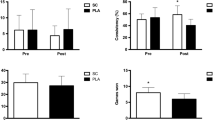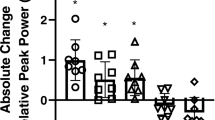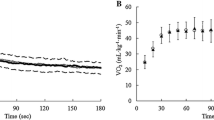Abstract
Purpose
Similarly to a wrestling match, upper-body intermittent sprint performance (UBISP) test elicits severe acidosis. This study aimed to determine whether sodium citrate (CIT) ingestion would help to better maintain peak power (PP) and mean power (MP) output across four consecutive UBISP tests simulating wrestling matches of a competition-day.
Methods
In a double-blind, counterbalanced, crossover manner, 11 trained wrestlers ingested either placebo (PLC) or CIT (900 mg kg−1) within a 17-h supplementation period. Thereafter they completed four (T1–T4) 6-min UBISP tests interspersed with 30-min recovery periods.
Results
Compared with PLC, CIT supplementation resulted in a persistent increase (P < 0.05) in blood HCO3 − concentration and pH: pre-T1 25.6 % and 0.08 units, post-T4 39.1 % and 0.14 units, respectively. Post-T1 blood lactate concentration in CIT (16.1 ± 3.8 mmol L−1) was higher (P = 0.037) than that in PLC (13.7 ± 2.3 mmol L−1). Decrease in plasma volume across the supplementation period and UBISP tests was greater (P = 0.03) in PLC (−6.91 ± 4.37 %) than in CIT (−1.51 ± 4.34 %). There was an overall decrease (P = 0.028) in ratings of perceived exertion in CIT compared with PLC, but no between-trial difference (P > 0.05) in PP or MP in any UBISP test occurred.
Conclusion
In trained wrestlers, CIT ingestion induces alkalosis, counteracts reduction in plasma volume, increases post-test blood lactate concentration and reduces perceived exertion, but does not improve PP or MP attained in consecutive UBISP tests simulating four wrestling matches of a competition-day.



Similar content being viewed by others
Abbreviations
- BE:
-
Base excess
- CIT:
-
Sodium citrate
- GID:
-
Gastrointestinal distress
- MP:
-
Mean power
- PLC:
-
Placebo
- Post-Ex:
-
After exercise
- PP:
-
Peak power
- Pre-Ex:
-
Before exercise
- RPE:
-
Rating of perceived exertion
- RPF:
-
Rating of perceived fatigue
- UBISP:
-
Upper-body intermittent sprint performance
- UOSM:
-
Urine osmolality
- USG:
-
Urine specific gravity
- VO2peak:
-
Peak oxygen consumption
References
Aedma M, Timpmann S, Ööpik V (2013) Effect of caffeine on upper-body anaerobic performance in wrestlers in simulated competition-day conditions. Int J Sport Nutr Exerc Metab 23:601–609
Allen DG, Lamb GD, Westerblad H (2008) Skeletal muscle fatigue: cellular mechanisms. Physiol Rev 88:287–332
Artioli GG, Gualano B, Coelho DF, Benatti FB, Gailey AW, Lancha AH (2007) Does sodium-bicarbonate ingestion improve simulated judo performance? Int J Sport Nutr Exerc Metab 17:206–217
Aschenbach W, Ocel J, Craft L, Ward C, Spangenburg E, Williams J (2000) Effect of oral sodium loading on high-intensity arm ergometry in college wrestlers. Med Sci Sports Exerc 32:669–675
Bellinger PM, Howe ST, Shing CM, Fell JW (2012) Effect of combined β-alanine and sodium bicarbonate supplementation on cycling performance. Med Sci Sports Exerc 44:1545–1551
Bishop D, Edge J, Davis C, Goodman C (2004) Induced metabolic alkalosis affects muscle metabolism and repeated-sprint ability. Med Sci Sports Exerc 36:807–813
Borg G (1998) Borg’s perceived exertion and pain scales. Human Kinetics, Champaign
Burke L, Cort M, Cox G, Crawford R, Desbrow B, Farthing L, Minehan M, Shaw N, Warnes O (2006) Supplements and sports foods. In: Burke L, Deakin V (eds) Clinical sports nutrition, 3rd edn. McGraw-Hill, Sydney, pp 485–579
Cairns SP (2006) Lactic acid and exercise performance: culprit or friend? Sports Med 36:279–291
Cameron SL, McLay-Cooke RT, Brown RC (2010) Increased blood pH but not performance with sodium bicarbonate supplementation in elite rugby union players. Int J Sport Nutr Exerc Metab 20:307–321
Carr AJ, Hopkins WG, Gore CJ (2011) Effects of acute alkalosis and acidosis on performance: a meta-analysis. Sports Med 41:801–814
Culbertson J, Kreider RB, Greenwood M, Cooke M (2010) Effects of ßeta-alanine on muscle carnosine and exercise performance: a review of the current literature. Nutrients 2:75–98
Dill DB, Costill DL (1974) Calculation of percentage changes in volumes of blood, plasma, and red cells in dehydration. J Appl Physiol 37:247–248
Edge J, Bishop D, Hill-Haas S, Dawson B, Goodman C (2006a) Comparison of muscle buffer capacity and repeated-sprint ability of untrained, endurance-trained and team-sport athletes. Eur J Appl Physiol 96:225–234
Edge J, Bishop D, Goodman C (2006b) The effects of training intensity on muscle buffer capacity in females. Eur J Appl Physiol 96:97–105
Flueck JL, Mettler S, Perret C (2014) Influence of caffeine and sodium citrate ingestion on 1,500-m exercise performance in elite wheelchair athletes: a pilot study. Int J Sport Nutr Exerc Metab 24:296–304
García-Pallarés J, López-Gullón JM, Muriel X, Díaz A, Izquierdo M (2011) Physical fitness factors to predict male Olympic wrestling performance. Eur J Appl Physiol 111:1747–1758
Garnier PL, Dubouchaud H, Mercier BM, Mercier JG, Ahmaidi S, Préfaut CG (1996) Effect of NaHCO3 on lactate kinetics in forearm muscles during leg exercise in man. Med Sci Sports Exerc 28:692–697
Hickner RC, Horswill CA, Welker JM, Scott J, Roemmich JN, Costill DL (1991) Test development for the study of physical performance in wrestlers following weight loss. Int J Sports Med 12:557–562
Hobson RM, Saunders B, Ball G, Harris RC, Sale C (2012) Effects of β-alanine supplementation on exercise performance: a meta-analysis. Amino Acids 43:25–37
Hollidge-Horvat MG, Parolin ML, Wong D, Jones NL, Heigenhauser GJF (2000) Effect of induced metabolic alkalosis on human skeletal muscle metabolism during exercise. Am J Physiol Endocrinol Metab 278:E316–E329
Hübner-Woźniak E, Lutoslawska G, Kosmol A, Zuziak S (2006) The effect of training experience on arm muscle anaerobic performance in wrestlers. Hum Mov 7:147–152
Ööpik V, Saaremets I, Medijainen L, Karelson K, Janson T, Timpmann S (2003) Effects of sodium citrate ingestion before exercise on endurance performance in well trained college runners. Br J Sports Med 37:485–489
Parkhouse WS, McKenzie DC, Hochachka PW, Mommsen P, Ovalle WK, Shinn SL, Rhodes EC (1983) The relationship between carnosine levels, buffering capacity, fiber type and anaerobic capacity in elite athletes. In: Knuttgen HG, Vogel JA, Poortmans J (eds) Biochemistry of exercise. Human Kinetics, Champaign, pp 590–594
Quesnele JJ, Laframboise MA, Wong JJ, Kim P, Wells GD (2014) The effects of beta-alanine supplementation on performance: a systematic review of the literature. Int J Sport Nutr Exerc Metab 24:14–27
Raymer GH, March GD, Kowalchuk JM, Thompson RT (2004) Metabolic effects of induced alkalosis during progressive forearm exercise to fatigue. J Appl Physiol 96:2050–2056
Requena B, Zabala M, Padial P, Feriche B (2005) Sodium bicarbonate and sodium citrate: ergogenic aids? J Strength Con Res 19:213–224
Robergs RA, Ghiasvand F, Parker D (2004) Biochemistry of exercise-induced metabolic acidosis. Am J Physiol 287:R502–R516
Robertson RJ, Falkel JE, Drash AL, Swank AM, Metz KF, Spungen SA, LeBoeuf JR (1987) Effect of induced alkalosis on physical work capacity during arm and leg exercise. Ergonomics 30:19–31
Russell C, Papadopoulos E, Mezil Y, Wells GD, Plyley MJ, Greenway M, Klentrou P (2014) Acute versus chronic supplementation of sodium citrate on 200-m performance in adolescent swimmers. J Int Soc Sports Nutr 11:26
Swank AM, Robertson RJ (2002) Effects of induced alkalosis on perception of exertion during exercise recovery. J Strentgh Cond Res 16:485–490
Timpmann S, Burk A, Medijainen L, Tamm M, Kreegipuu K, Vähi M, Unt E, Ööpik V (2012) Dietary sodium citrate supplementation enhances rehydration and recovery from rapid body mass loss in trained wrestlers. Appl Physiol Nutr Metab 37:1028–1037
Tobias G, Benatti FB, Salles Painelli V, Roschel H, Gualano B, Sale C, Harris RC, Lancha AH, Artioli GG (2013) Additive effects of beta-alanine and sodium bicarbonate on upper-body intermittent performance. Amino Acids 45:309–317
Van Montfoort MCE, Van Dieren L, Hopkins WG, Shearman JP (2004) Effects of ingestion of bicarbonate, citrate, lactate, and chloride on sprint running. Med Sci Sports Exerc 36:1239–1243
Walberg Rankin J, Ocel JV, Craft LL (1996) Effect of weight loss and refeeding diet composition on anaerobic performance in wrestlers. Med Sci Sports Exerc 28:1292–1299
Zabala M, Peinado AB, Calderon FJ, Sampedro J, Castillo MJ, Benito PJ (2011) Bicarbonate ingestion has no ergogenic effect on consecutive all out sprint tests in BMX elite cyclists. Eur J Appl Physiol 111:3127–3134
Zajac A, Cholewa J, Poprzecki S, Waskiewsicz Z, Langfort J (2009) Effects of sodium bicarbonate ingestion on swim performance in youth athletes. J Sports Sci Med 8:45–50
Zinner C, Wahl P, Achtzehn S, Sperlich B, Mester J (2011) Effects of bicarbonate ingestion and H+-ion distribution in different blood compartments. Eur J Appl Physiol 111:1641–1648
Acknowledgments
The study was supported by institutional research funding IUT 20-58 of the Estonian Ministry of Education and Research. The authors are sincerely grateful to the athletes who participated in the experiments and to Prof. Hannu Rintamäki for a valuable methodological help in the process of preparation of the study.
Conflict of interest
The authors of this article do not have any conflict of interests.
Author information
Authors and Affiliations
Corresponding author
Additional information
Communicated by Michael Lindinger.
Rights and permissions
About this article
Cite this article
Aedma, M., Timpmann, S. & Ööpik, V. Dietary sodium citrate supplementation does not improve upper-body anaerobic performance in trained wrestlers in simulated competition-day conditions. Eur J Appl Physiol 115, 387–396 (2015). https://doi.org/10.1007/s00421-014-3025-4
Received:
Accepted:
Published:
Issue Date:
DOI: https://doi.org/10.1007/s00421-014-3025-4




